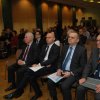Induced seismicity is the result of human technological activity and is manifested by dynamic phenomena in the form of shocks and vibrations of surface of the earth. A typical example is the seismicity resulting from the operation of mines that disturbs the natural state of balance in the rock causing these shocks and vibrations. There is no doubt that the occurrence of such phenomena can be a major problem, particularly for the residents of areas where mining activity is carried out. It was clearly proved by recent events occurring in the mining area of Janina Mine in Libiąż and the surrounding area. Therefore, it is important to regularly conduct studies of induced seismicity.
This year ends with the implementation of an important and prestigious project "IS-EPOS - Digital Research Space of Induced Seismic for EPOS Purposes."
EPOS (European Plate Observing System) is the largest European project in the field of research infrastructures aimed at the science of the earth, which includes a network of seismological, geodetic, satellite observations and in-situ laboratories.
The IS-EPOS project - Digital Research Space of Induced Seismic for EPOS Purposes started on November 1, 2013 and ends on December 31, 2015. It is led by scientific and industrial consortium, comprising:
- Institute of Geophysics PAS - Project co-ordinator
- Academic Computer Centre CYFRONET AGH
- The Central Mining Institute
- Kompania Węglowa S.A.
The project is financed by the National Research and Development Centre funded by the European Regional Development Fund, with a budget of more than 16.7mln PLN. The project manager is Professor Stanisław Lasocki, IGF PAN.
IS-EPOS is a prototype implementation of an innovative idea of infrastructure integration, aimed at research on the impact of the Earth's natural resources exploitation on the environment, developed in IGF PAN - says Professor Lasocki, the project manager.
Growing demand for energy and raw materials means that they will be obtained in increasingly difficult environments. The risks related to the problem of exploitation of the earth's resources is especially important in densely populated Europe, where this type of industrial activity takes place in an inhabited area or near protected areas. Integration of research is an opportunity to improve the identification and control of these risks. In order to implement this concept of the integration, in 2011 the IGF PAN team launched a working group within the framework of the EPOS project. This group, led by Professor Beata Borecka-Sikora and Professor Stanisław Lasocki, gathered representatives of scientific and industrial institutions from 15 European countries.
The integration system of research infrastructures was so innovative that the management of the EPOS doubted its ability to implement. As a result, the Polish working group members formed a consortium to build a fully functional prototype of the system - says Professor Orlecka-Sikora, Director of IGF PAN.
The prototype advanced digital platform, developed within the framework of the project, will be used to gather and interpret measurement data collected in various places, including mines, as well as during exploitation of the geothermal water or gas from shale. Digital platform uses powerful computers and the biggest information core networks in Europe by Polish PL-Grid network, owned by to the European Grid Infrastructure. It provides open access to integrated data and processing services.
As a result, Polish industry and other sectors of the economy, research centres and public administration will benefit from the extensive database related to induced seismicity available online, and so will be able to quickly access the information about the risks associated with different types of occurring anthropogenic seismicity - says Professor Józef Dubiński from the Central Mining Institute. GIG together with KW SA created a Virtual Laboratory for Monitoring of Seismic Activity Induced by Exploitation (LMMIS). The Laboratory is based on seismological network of Bobrek Mine and the Upper Silesian Regional Seismological Network of GIG.
The prototype platform constructed as part of the IS-EPOS became the evidence of the feasibility of the Polish concept of integrating research infrastructures. It will be developed as the European project "EPOS Implementation Phase" within specially dedicated Work Package, and led by Polish group and implemented within the Horizon 2020, EU's research program. The budget for this project exceeds 3.5mln Euro. It has already proved to be useful as the prototype has been appreciated and it is used to support the European research project called “Shale Gas Exploration and Exploitation Risks” within Horizon 2020.
The platform was presented for the first time at the international conference "Digital Research Space for Anthropogenic Hazard Studies” on November 19-20 this year and held at the Central Mining Institute in Katowice. The conference was organized by the Institute of Geophysics, Warsaw (IGF PAS) and the Central Mining Institute (GIG), under the patronage of the Minister of Science and Higher Education, the Minister of Economy, and the National Centre for Research and Development.






